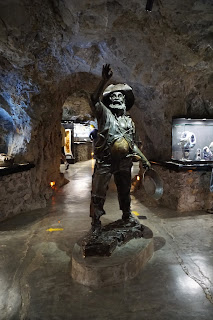Saturday, 31 March 2018
Huichol Art
El Eden Mine in Zacatecas
The tour of El Eden Mine is approximately a mile long and features galleries, hanging bridges and tunnels, allowing one to imagine the complicated working conditions the miners had to suffer many years ago. The tour is enriched by an interesting and detailed explanation that describes the mining activity here, which was at its peak during the 17th and 18th centuries, with gold and silver being the main products extracted from the mine. It features a total of seven floors but the tour takes place on the fourth floor, from where you can see how flooded the lower levels of the mine still are.
Mining ended at 'El Eden' in 1960 and nowadays it is the most important tourist attraction in the state, where you can take a step back into the grandiose mining past of Zacatecas.
Not to be missed is the innovative El Malacate Discotheque which is located in a vault that was once used to grind the minerals and is now a state of the art nightclub. Access to the discotheque is via a small train through La Esperanza Cavern, a tunnel 656 yards long.
Subscribe to:
Posts (Atom)































































































